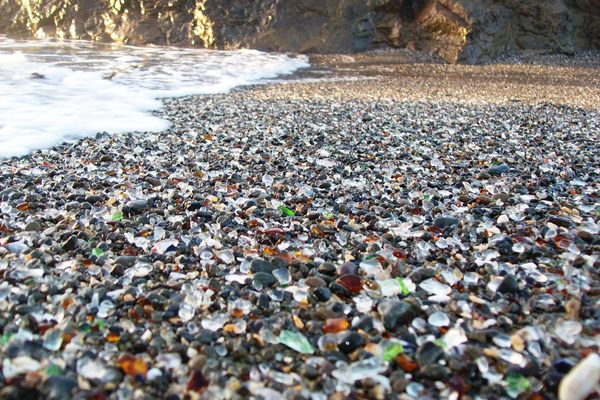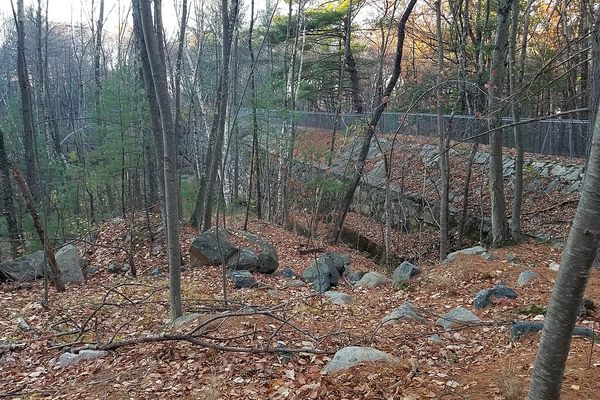When Trash Becomes Treasure: The Iridescent Beauty of Glass Beaches
A close-up of glass pebbles worn down by ocean waves, originally pieces of bottles and dishes, on Glass Beach in Fort Bragg, California. (Photograph by mamajo, via Flickr)
Nobody ever really meant to make a glass beach. Like many of the best things in the world, it just happened. Mother Nature took cast-off glass bottles, dishes, and vehicle tail lights, ground them down under the ceaseless motion of the ocean, and cast them back on the land, more beautiful than before.
History’s trash is now today’s treasure. The smooth glass castoffs are highly sought after by collectors, crafters, and souvenir hunters. The hobby has its own publication, the Sea Glass Journal (slogan: “It’s not the destination, it’s the sea glass!”), which also helpfully tracks sea glass festivals and events in a database.

There’s no indication sea glass harms animals, unlike junk washed ashore on the infamous Kamilo Beach in Hawaii, which collects garbage from the Great Pacific Garbage Patch. And the smoothed glass doesn’t rust or leach chemicals, unlike metal items fusing and rusting near one of the sea glass beaches described below.
Here are two popular and three less commonly known beaches perfect for hunters of that rare, ruby-red glass pebble or tiny sapphire-colored globe. For the closest thing out there to a global sea glass database, check out Odyssey Sea Glass’s database.
Glass Beach
MacKerricher State Park
Fort Bragg, California
The waves wash over the mix of rocks and ground-down glass pieces on the site of a former trash dump, now Glass Beach in Fort Bragg, California (photograph by Ellin Beltz)
For decades until 1967, seaside communities in Fort Bragg, California — around what’s now known as Glass Beach — threw their garbage in an area called “the Dumps” for the sea to take or leave. On occasion, the trash would be burned.
State and local authorities stopped the activity in the late 1960s and worked to clean up the area. The ocean took care of the rest, taking glass from the beach and surf and pounding it to pieces round and smooth. The beach, once covered in glass bits, has been depleted by excessive collecting in recent years, a discouraging find for those who come to visit the beach for the glass.
State officials have stressed that collectors must leave glass on the beach as objects of historic interest, but that doesn’t seem to stop anyone. Locals have also discussed replenishing the beach with glass pebbles, artificially tumbled. For a great collection of glass pieces found on the beach, however, there is the nearby International Sea Glass Museum.
photograph by Annetta Black
Glass Beach
Kauai, Hawaii
Glass Beach on Kauai, Hawaii, is another former dump site, still at the ocean edge of an industrial area along Hanapepe Bay (photograph by Travis Thurston)
Hawaii’s own Glass Beach, on the southern end of the island of Kauai near Port Allen Harbor, is partly the result of trash dumping and partly the product of a unique geological structure nearby known as the Swiss Cheese Shoreline.
The beach, in an industrial part of Hanapepe Bay, served as a trash dump for decades, and the Swiss Cheese Shoreline’s hole-y lava rocks worked as the anvil upon which the waves smashed trash to bits and fused metal garbage. Like California’s Glass Beach, Hawaii’s version has far fewer glass pebbles than in the past. But there are still plenty to find.
photograph by Jason Popesku
Homer Spit Beach
Homer, Alaska
The gravel and stones along Homer Spit Beach in Homer, Alaska, hide gems sought after by those known as “glass hunters.” (photograph by Brian, via Flickr)
Homer Spit Beach isn’t commonly swarmed by glass hunters, but that’s the point.
Reports indicate this Alaskan beach hosts a lot of glass treasures among its large, round rocks and gravel, although fewer in the beach’s sand. Beachcombers occasionally find rare Japanese fishing floats here as well, along with shells and random flotsam.
Alexandra Battery Beach, Dockyard Beach
Bermuda
Alexandra Battery overlooks a small beach home to numerous glass pebbles & the site where in 1610 a crew of shipwreck survivors built a boat they christened “Deliverance” (photograph by Jerry & Roy Klotz MD)
Bermuda’s been home to an active seaport since the 1600s, and remains a center for a significant rum manufacturing and export industry. Between shipwrecks, bottles of booze, and the usual glass garbage of several centuries, a number of Bermuda beaches are prime places to find sea glass.
Hunters say Alexandra Battery Beach, below the guns of an old fort, and Dockyard Beach reveal some sea-tumbled gems.
Sea glass on a Bermuda beach (photograph by nathanmac87/Flickr user)













Follow us on Twitter to get the latest on the world's hidden wonders.
Like us on Facebook to get the latest on the world's hidden wonders.
Follow us on Twitter Like us on Facebook